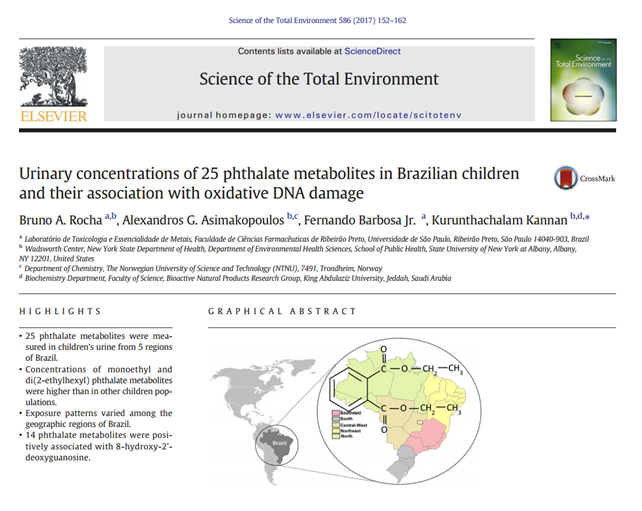Identification and quantification of 25 phthalates metabolities
Identification and quantification of 25 phthalate metabolites

Exposure of humans to phthalates has received considerable attention due to the ubiquitous occurrence and potential adverse health effects of these chemicals. Nevertheless, little is known about the exposure of the Brazilian population to phthalates.
In this study, concentrations of 25 phthalate metabolites were determined in urine samples collected from 300 Brazilian children (6–14 years old). Further, the association between urinary phthalate concentrations and a biomarker of oxidative stress, 8-hydroxy-2′-deoxyguanosine (8OHDG), was examined.
Overall, eleven phthalate metabolites were found in at least 95% of the samples analyzed. The highest median concentrations were found for monoethyl phthalate (mEP; 57.3 ng mL−1 ), mono-(2-ethyl-5-carboxypentyl) phthalate (mECPP; 52.8 ng mL−1 ), mono-isobutyl phthalate (mIBP; 43.8 ng mL−1 ), and mono-n-butyl phthalate (mBP; 42.4 ng mL−1 ). The secondary metabolites of di(2-ethylhexyl) phthalate (DEHP), and mEP, mIBP, and mBP were the most abundant compounds, accounting for N90% of the total concentrations.
On the basis of the measured concentrations of urinary phthalate metabolites, we estimated daily intakes of the parent phthalates, which were 0.3, 1.7, 1.8, 2.1, and 7.2 μg/kg-bw/day for dimethyl phthalate, di-n-butyl phthalate, diisobutyl phthalate, diethyl phthalate, and DEHP, respectively. Approximately one-quarter of the Brazilian children had a hazard index of >1 for phthalate exposures.
Statistically significant positive associations were found between 8OHDG and the concentration of the sum of phthalate metabolites, sum of DEHP metabolites, mEP, mIBP, mBP, monomethyl phthalate, mono(3-carboxypropyl) phthalate, monobenzyl phthalate, monocarboxyoctylphthalate, monocarboxynonyl phthalate, monoisopentyl phthalate, and mono-n-propyl phthalate.
To the best of our knowledge, this is the first study to report the exposure of a Brazilian population to phthalates
Reference for more reading: B.A. Rocha, A.G. Asimakopoulos, F. Barbosa, K. Kannan. Urinary concentrations of 25 phthalate metabolites in Brazilian children and their association with oxidative DNA damage. Science of The Total Environment, 2017, 586, 152-162
